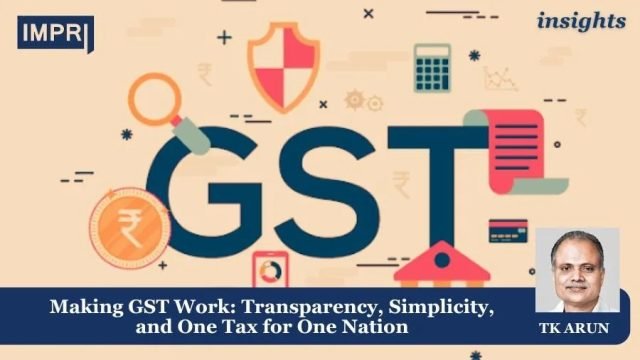TK Arun
As the GST Council goes about overhauling the tax over the next two days, here are a few suggestions to improve its working.
Mandate use of e-rupee, RBI’s digital currency, for all GST payments
According to GoI’s response to a question in Parliament, there have been 42,673 instances of input tax credit fraud, worth ₹1,66,241 cr, cumulatively over FY21 and FY25 (up to January for the last fiscal). Shell companies issue fake invoices for goods and services never actually sold, but claim to have paid GST on the invoiced goods and services, for which the alleged buyer claims input tax credit. The simple way to eliminate such fraud is to put all GST payments on a blockchain.
Blockchains have a bad rap in India, because of their association with cryptocurrencies, and the holy terror these hold for RBI. If alternative, private currencies are allowed, what would happen to the power of the monetary authority, and its ability to set interest rates and control inflation, employment and/or the exchange rate?
Yes, cryptocurrencies exist on some blockchain or the other. A blockchain is an open ledger distributed across a computer network, each block in the chain authenticated by multiple agents. Blockchains can be used for purposes other than crypto generation and transaction. Blockchains can be — and are — used to establish traceability of inputs that go into processed, packaged food, for example.
Suppose each GST payment is tokenised — the payment record, complete with details as to the sale (from whom to whom) on which the tax was paid, when it was paid, is made into a token that can be stored and tracked on the blockchain. The scope for input tax credit fraud becomes zero. You don’t need the e-rupee or its blockchain to create such tokens.
But the e-rupee is on blockchain, and payments made using blockchain easily lend themselves to being converted into tokens that can’t be duplicated. The surest way to achieve total transparency and traceability of GST payments is to make it happen on the blockchain on which the e-rupee operates, and through the e-rupee.
As many as 15 banks offer e-rupee wallets, and the facility of converting bank account holdings to e-rupees and vice-versa. GST amounts can be paid out of the payer’s e-rupee wallet to GoI’s. Making use of the e-rupee to pay GST can do away with the e-way bill too. Tokens on the blockchain make it clear the transported good is being sold by whom to whom, complete with all details.
Clearly define luxury or ‘sin’ consumption Properly classify a luxury good.
It should be distinguished from a premium good. Nobody shells out ₹20 lakh for a Birkin bag from Hermès because it is stiffer than a plain cloth jhola, and relatively easier in which to rummage for an elusive chapstick.
What the customer buys is exclusivity, a marker of being a cut above hoi polloi. Superior, or Veblen, goods are defined as goods, the demand for which rises when the price goes up.
Luxury should be narrowly defined in this fashion, to avoid conflating it with premium goods. You might get better coffee, depending on your taste, at an Udupi joint. But you pay 5× that price at a coffee chain outlet, because you get a different ambience, free Wi-Fi, and fellow coffee drinkers sorted by their elevated income. But this coffee joint deserves to be classified as premium, rather than luxury.
There is no need for a separate tax rate for premium goods. They are priced higher, and so would yield more tax, as compared to regular goods. Taxing ‘sin’ goods calls for clarity on what constitutes ‘sin’ and consequences of steep rates of tax.
‘Sin’, in this context, is defined in terms of implications for health, not whether you would be pointed up or down in the afterlife. Steep rates, combined with lax governance, will lead to smuggled goods and knock-offs, both resulting in loss to the exchequer.
Keep categories simple
Make categories broad enough to avoid disputes and litigation over classification — popcorn with caramel, without caramel, with flavour, without flavour, etc. They should all be in the same class of goods, and attract the same tax rate.
Avoid levying different rates on the same product or service presumably consumed by different income classes
There might be a temptation to levy a lower rate of tax on small packs of, say, shampoo or detergent, on the ground that the poor are more likely to buy these than the well-off.
Such differential rates of tax on the same product based on size of the stock-keeping unit (SKU) will only create anew industry of buying up small, lowtaxed SKUs, emptying contents into larger containers more convenient to use, and selling repackaged goods informally at a discount to the original manufacturer’s larger SKUs that attracts a higher rate of tax.
One nation, one tax, really
Let states and Centre pool their GST registration authority, and delegate it to a single, nationwide agency under the GST Council’s control, to permit one, single registration by any tax-paying entity to operate anywhere in India.
A coffee producer in Karnataka having to register as a GST payer in all the states where its coffee is sold is ridiculous. Registration should be centralised, with a unique, countrywide identity number. Tokenised GST payments would ensure all the transparency that is needed.
TK Arun is a senior journalist based in Delhi.
The article was first published in The Economic Times as Make GST payments only by e-rupee, tokenisation can achieve total transparency on 2nd September
Disclaimer: All views expressed in the article belong solely to the author and not necessarily to the organisation.
Read more at IMPRI:
India–Gulf Countries: Circular Economy Partnerships
Strengthening Social Security: Pradhan Mantri Jeevan Jyoti Bima Yojana (PMJJBY), 2015
Acknowledgment: This article was posted by Madhur Thapar, a Visiting Researcher at IMPRI.



















